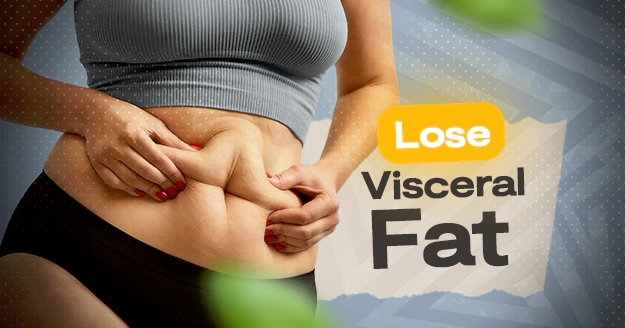What is visceral fat?
The majority of our fat is stored beneath the skin, which we refer to as subcutaneous fat. That is the fat that is visible and palpable. While the rest of the fat is hidden and is called visceral fat. Because it is hidden, not all working out for fat loss can get rid of visceral fats.
These fats are stored deep inside the belly, wrapped around the organs, including the liver and intestines. It makes up about 110th of all the fat stored in the body, and makes the belly stick out or gives a person an ‘apple’ shape.
Visceral fat is more dangerous than subcutaneous fat because it produces more toxic substances. Visceral fat poses a number of health risks, even in thin people.
What causes visceral fat? Fat gets stored when you consume too many calories beyond your TDEE and have too little physical activity.
Is visceral fat hard to lose?
Visceral fat is less difficult to lose than subcutaneous fat. This is because it metabolizes faster, and your body can eliminate it through sweat or urine. If you start exercising regularly and eating a healthy diet, you should see results in two to three months.
If you’re looking to lose visceral fat, there are a few things you can do to help. Continue reading to find out how to lose visceral fat.
Tips on How To Lose Visceral Fat
Eat a healthy diet
Lean proteins, whole grains, low-fat dairy, fruits and vegetables are all part of a healthy diet. Limit your intake of trans fats, refined sugars, sodium, and processed foods. Low-carb diets, such as the ketogenic diet, can help reduce visceral fat by training your body to burn fat instead of carbs as fuel.
Exercise regularly
The best exercise to lose fat is an aerobic activity, such as brisk walking. Strength training, such as weightlifting exercises, can also help reduce or prevent the growth of visceral fat. Exercising regularly can also keep fat from coming back.
Other best exercises to lose fat include:
- Walking
- Jogging or running
- Cycling
- Swimming
- Pilates
Manage stress levels
Cortisol, a hormone in your body, is activated by stress. More cortisol activates your body’s “fight-or-flight” response, which causes more visceral fat to be stored. To reduce stress, you can try adding yoga or meditation to your daily routine.
Get enough sleep
Inadequate sleep results in an increase in calorie intake, body fat, and belly fat. Compared to those who slept 9 hours a night, people who slept four hours a night had a 9% increase in subcutaneous belly fat and an 11% increase in abdominal visceral fat.
Get a restful night’s sleep. Not getting enough sleep may increase your chances of gaining extra visceral fat. Try to get at least seven hours of sleep per night, preferably, you should be asleep already around 10 pm.
Limit alcohol consumption
Drinking beer can impair your body’s ability to burn fat efficiently. Before it gets to any stored fat that needs to be burned, the body will work on breaking down alcohol for energy. Drinking too much alcohol may cause your body to store more visceral fat and can cause other health problems.
Conclusion
Visceral fat may not be visible, but that doesn’t mean you shouldn’t be concerned. Excessive visceral fat can be harmful to your health and can cause high blood pressure, obesity, high cholesterol, and insulin resistance. Fortunately, visceral fat is less difficult to reduce than visible subcutaneous fat. Share this article with your friends and family who want to reduce their visceral fat and want to start living healthier.











